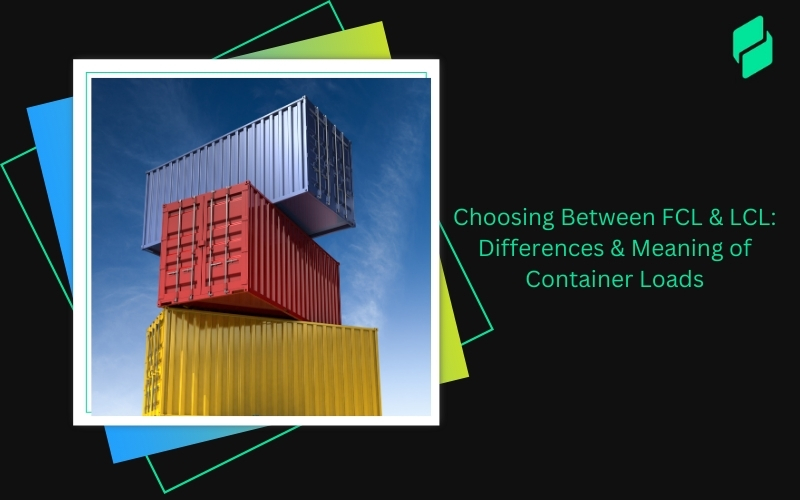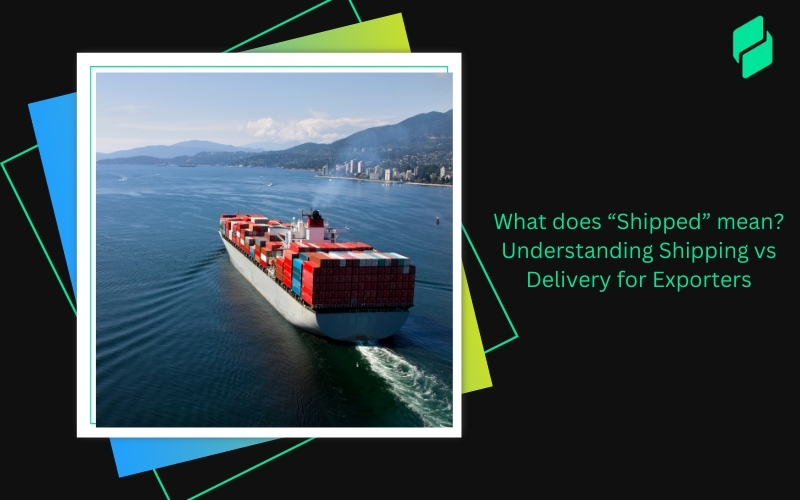Optimize your business: use unlimited savings with Pazago fulfilled now!
Get Started ->Did you know that the Bill of Lading (B/L) accounts for between 10% and 30% of total trade documentation costs? That's a significant percentage, especially when you consider that international shipping involves various paperwork that must be handled carefully.
If you're an Indian exporter, getting the right Bill of Lading can directly affect the speed, cost, and safety of your shipments. However, with multiple options like the House Bill of Lading (HBL) and Master Bill of Lading (MBL), knowing which one to choose can be confusing.
In this blog, we'll explore the essential differences between the HBL and MBL, their roles in the shipping process, and the impact they have on your business. Whether you're new to exporting or looking to optimize your current processes, understanding these two types of Bills of Lading will help you make smarter decisions for your shipping needs.
What is a House Bill of Lading (HBL)?

A House Bill of Lading (HBL) is a document issued by a freight forwarder or a Non-Vessel Operating Common Carrier (NVOCC). It acts as a receipt for the goods you're shipping and functions as a contract between you, the exporter, and the freight forwarder handling your shipment.
In simple terms, if you are shipping goods through a freight forwarder who combines multiple shipments into one container, the HBL applies to your specific goods in that container.
When is a House Bill of Lading Used?
The HBL is typically used for Less than Container Load (LCL) shipments. When you're sending smaller amounts of goods that don't fill an entire container, a freight forwarder consolidates your cargo with others. The HBL then tracks your portion of the goods.
Here are some common situations for using an HBL:
- Smaller Shipments: When your goods don't fill a full container, an HBL is issued for your portion.
- Consolidation: When a freight forwarder combines multiple shipments into one container, an HBL is issued to each exporter.
- Multiple Intermediaries: If your goods are handled by different parties along the way, the HBL helps ensure the correct documentation for each portion of the shipment.
Now that we've covered the HBL shipping, let's move on to its counterpart, the Master Bill of Lading, and understand its purpose.
What is a Master Bill of Lading (MBL)?

A Master Bill of Lading (MBL) is issued by the main carrier or shipping line. It acts as the main agreement between the carrier and the shipper, outlining the terms of the transportation. The MBL covers the entire shipment, which could involve one or more consignments within a container.
If you're shipping a full container load (FCL) or handling the shipment directly with the carrier, the MBL will apply. This document serves as an official record, outlining all the details of the shipment, from when it leaves its origin to when it reaches its final destination.
When is a Master Bill of Lading Used?
The MBL is used primarily in Full Container Load (FCL) shipments. If you're shipping enough goods to fill an entire container or have a direct relationship with the carrier, you'll deal with an MBL.
Here are some scenarios where the MBL is typically used:
- Full Container Load (FCL): When your shipment fills an entire container, the MBL will cover all the goods within that container.
- Direct Relationship with Carrier: If you're shipping directly with a carrier (not through a freight forwarder), the MBL will be used to document the shipment.
- Single Exporter or Shipper: If only one exporter is shipping goods in the container, the MBL will be issued, covering all the goods within the shipment.
In short, when you are dealing with a full shipment and a direct relationship with the carrier, the MBL is the primary document. It acts as the official contract between you and the carrier for the entire shipment.
To better understand their roles in shipping, let's directly compare the House and Master Bills of Lading.
Comparing House Bill of Lading and Master Bill of Lading
The main differences between HBL vs MBL lie in the issuer (freight forwarder vs. main carrier), purpose (individual consignments vs. full shipment), and usage (LCL vs. FCL). To make it easier to understand the differences between HBL shipping and MBL, here's a straightforward comparison:
With a clear understanding of the differences, it's time to figure out which Bill of Lading best suits your needs.
Choosing the Right Bill of Lading

When it comes to choosing between a HBL shipping and a MBL, there are several factors to consider. The best choice depends on your shipment size, the logistics involved, and who's handling the process. Here's a simple way to figure it out:
- Shipment Size: LCL or FCL?
LCL (Less than Container Load): If your shipment doesn't fill an entire container, you'll most likely need a House Bill of Lading. Since your goods will be consolidated with others, the HBL helps track your specific cargo within a shared container.
FCL (Full Container Load): If your shipment fills an entire container, a Master Bill of Lading is typically used. The MBL provides the necessary documentation for the full shipment, and since you control the entire container, it's a simpler process.
- Who's Handling the Shipment?
If you're working with a freight forwarder or NVOCC, you'll typically get a House Bill of Lading. Freight forwarders consolidate multiple shipments, and each consignment gets its own HBL, even if they share space in one container.
If you have a direct relationship with a shipping carrier, then the Master Bill of Lading is the usual choice. The MBL will cover the entire shipment, and the shipping line will take responsibility for the cargo.
- Cost Considerations
Freight forwarders might charge you a fee for issuing an HBL, but this could be more cost-effective if you're only shipping small amounts of goods. However, if you're shipping a full container, using an MBL can reduce some administrative overhead by consolidating the shipment under one document.
Keep in mind that freight forwarders may offer better rates for LCL shipments, but they also add their handling costs. If you're shipping larger quantities, it may be more economical to go directly with the carrier and use the MBL.
- Risk and Liability
The Master Bill of Lading typically offers more clarity in terms of liability because it's issued by the main carrier, who is responsible for the entire container. The terms and conditions of the MBL apply to the whole shipment.
The House Bill of Lading, on the other hand, governs your specific portion of the shipment. It's important to go through the terms thoroughly, as the responsibility could change when dealing with a freight forwarder. If anything goes wrong, the freight forwarder will be responsible for handling claims.
- Documentation and Tracking
With the HBL, since multiple parties are involved, tracking and documentation may be more complex. You'll need to keep track of not just your own goods but also the overall container and other parties' cargo.
The MBL is simpler in terms of tracking, as it covers the entire shipment. With only one bill to manage, it's easier to monitor your goods and ensure everything moves according to plan.
Choosing the correct Bill of Lading is key, but how you manage it makes all the difference. Let's look at how Pazago can help.
How Pazago Simplifies Export Documentation and Operations

Pazago is an all-in-one platform designed to streamline your export process, making shipping and documentation more efficient and less error-prone.
Simplified Documentation Management
Pazago helps you consolidate all your export documents into one place. This means no more scrambling for essential paperwork or worrying about missing documents at critical stages.
- Centralized Document Storage: All your vital export documents, like a bill of lading, commercial invoices, certificates of origin, and packing lists, are organized and accessible in one location.
- Real-Time Collaboration: You can easily share, review, and approve documents in real time with your team, freight forwarders, customs agents, and buyers. This reduces delays and ensures everyone is on the same page, keeping the process smooth.
End-to-End Export Optimization
Pazago goes beyond just managing documents. It optimizes your entire export journey. From finding the best logistics routes to handling payments, it ensures your operations are faster and more cost-effective.
- Affordable Cross-Border Logistics: Pazago helps identify the most efficient and affordable shipping routes, saving you money while ensuring timely deliveries.
- Real-Time Shipment Tracking: Track your shipments at every stage, allowing you to make adjustments and avoid delays.
- Simplified Payments: Pazago offers tools for smoother payment processing and currency conversion, minimizing risks related to international transactions.
- Quality Assurance: Schedule inspections before your goods leave, ensuring they meet international standards and reducing the risk of returns or compliance issues.
By integrating Pazago into your export operations, you can simplify your workflow, avoid costly errors, and enhance the profitability of your business.
To Sum Up!
Understanding the differences between HBL shipping and MBL is important for making informed decisions that impact the efficiency and cost-effectiveness of your export operations. Whether managing smaller shipments with a freight forwarder or handling full container loads directly with a shipping carrier, choosing the right Bill of Lading ensures your cargo is documented correctly and safely.
By incorporating Pazago into your export process, you can simplify documentation management, optimize logistics, and reduce the risks of international shipping. With its real-time collaboration, tracking, and payment tools, Pazago makes it easier to stay on top of your operations and keep everything running smoothly.
Want to see how Pazago can transform your export workflow? Book a demo today and discover how our platform can simplify your shipping and documentation processes for better efficiency and cost savings.


.png)








